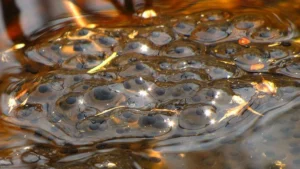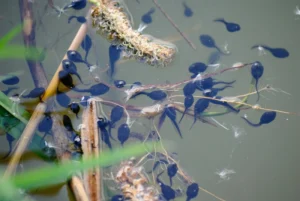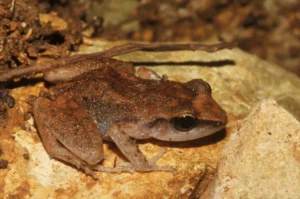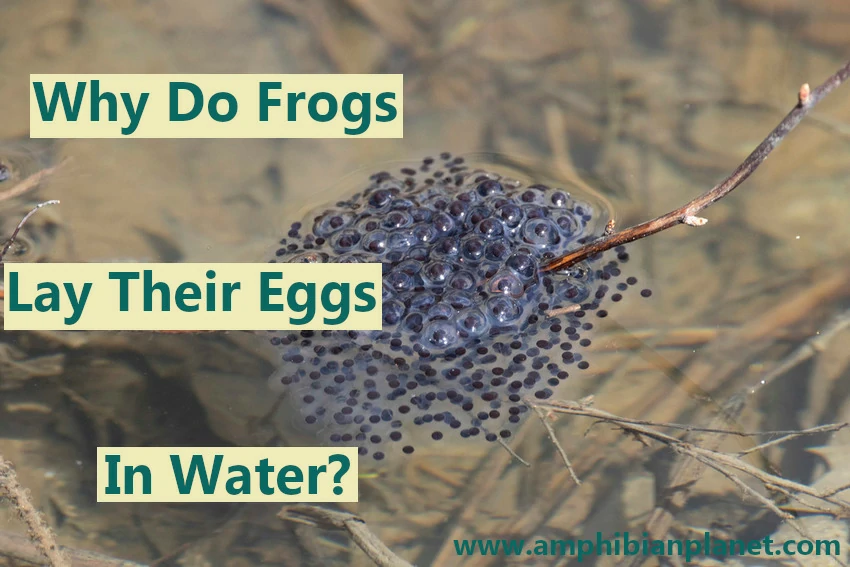There are over 7,000 frog species around the world. Most of these species reproduce by laying eggs, usually in shallow, standing, or slow-moving freshwater bodies free that are free of predatory fish.
Frogs lay eggs in water to protect, and prevent them from drying out. Unlike reptile or bird eggs, frog eggs do not have a hard protective shell. Rather, each egg is covered with a thick jelly coating. The jelly holds the eggs together and protects the developing embryos from the elements.
When first laid, frog egg masses are very dense and tightly packed together. Over time, the jelly surrounding the eggs absorbs water, swelling up.
For the jelly to effectively protect the developing embryos, it requires a source of moisture. If there is insufficient moisture, the eggs can dry up, killing the developing embryos.
The Reasons Many Frog Species Lay Their Eggs in Water
As earlier mentioned, most frog species lay their eggs in shallow, standing, or slow-moving freshwater bodies that are free of predatory fish.
This could be in woodland ponds, reservoirs, seasonal pools, river margins, lake edges, river backwaters, bogs, marshes, swamps, temporary rain puddles, and even in roadside ditches, deep tire tracks, or potholes filled with rainwater.
Some frog species such as the American green tree frog (Hyla cinerea) occasionally lay their eggs in water bodies with fish.
Other frog species such as the Coastal Tailed Frog (Ascaphus truei), and the waterfall frog (Ranoidea nannotis) lay their eggs in fast-flowing streams, and attach them underneath large rocks.
There are several reasons as to why many frog species lay their eggs in water:
1. Water Cushions the Eggs, and Protects the Developing Embryos
Birds and many reptiles eggs have hard outer shells. The shell protects and supports the internal soft structures, and also prevents desiccation of the eggs.
Frog eggs, on the other hand, do not have a protective shell. Rather, each egg is covered by a thick protective coating.

This jelly enables the eggs to float near the surface of the water, where it is warmer and there is more oxygen.
The jelly also holds the eggs together and protects the developing embryos from the elements by virtue of its sticky texture and its tendency to accumulate a covering of pond debris.
In addition, it acts as a “shock absorber” to prevent injury to the egg from the water movement.
Since frog eggs are soft and most they require cushioning to prevent injury to the developing embryos. Water provides the required cushioning.
2. Water Enables the Jelly of the Eggs to Expand
When first laid, frog egg masses are very tightly packed together, and are embedded in special secretions from a gland in the frog’s body.

These secretions combine with water to create a jelly-like coating around each egg, and the egg mass loosens up.
Laying eggs in the water enables the jelly coating of the eggs to expand and provides effective protection for the developing embryos.
3. Water Prevents Frog Eggs from Drying Out
Frog eggs require moisture to properly develop. The jelly of the eggs prevents the eggs from drying out, but it needs to be kept in contact with a source of moisture. Water provides this moisture.
Since most frogs lay their eggs clamped together, some of the eggs may be exposed at the surface of the water, and may dry out, killing the developing embryos. However, the eggs that are in contact with the water will be kept moist and will not dry out.
Some frog species such as the Fletcher’s frog (Platyplectrum fletcheri) of eastern Australia, build froth nests in the water in which they deposit their eggs.
The froth nesting serves as a line of defense for the eggs, shielding them from the elements, and also from the sight of some predators.
Most notably, it serves as an effective protection against desiccation. The nest’s protective quality is further enhanced when the outer mucus dries to form a hard outer cast, reducing water loss by reflecting solar radiation and trapping moisture.
The protection is so effective that Fletcher’s frog eggs can survive and even continue developing for several days even if the water they were laid in dries up.
4. Water Shields the Eggs from Harmful Temperatures
Many frogs have extended breeding seasons and their eggs are exposed to a wide range of temperatures depending on the time of year when they are laid.
For frog embryos to develop normally, the surrounding temperature should stay within a certain range.
If the temperatures fall beyond their preferred range, their development rate decreases, meaning they will take longer to hatch. And if the temperatures drop too low, the embryos can die.
On the opposite end, if the temperatures rise above the preferred range, the developing embryos may overheat which can lead to a very high mortality rate.
Late frosts or an early warm spell followed by freezing conditions can result in spawn (especially any exposed above the water) to succumb to frost damage, killing the developing eggs.
Laying eggs in the water provides them with some form of protection from the natural elements.
5. Water Protects the Eggs from Some Predators on Land
Most frog species do not show parental care for their eggs. After the mating is complete, both the males and females will leave the pond, abandoning the eggs.
This means the eggs are left alone to fend for themselves, and are vulnerable to many predators.
Laying eggs in the water protects the eggs from some predators that only hunt on land.
However, many water bodies such as rivers or lakes also have many predators, such as predetory fish.
For this reason, many frog species will only lay their eggs in fish-free bodies of freshwater. This could be in woodland ponds, temporary rain puddles, or other water bodies.
Many frogs species, such as the wood frog (Lithobates sylvaticus), spring peeper (Pseudacris crucifer), and the pacific tree frog (Pseudacris regilla), like to breed in something called “vernal pools“.

Vernal pools are temporal pools of water that form in the spring. They are formed when depressions on the ground are filled with water from melting snow and falling rain.
They are typically small and shallow, and unlike a pond or lake, they have no permanent source of water. This means they dry up in the summer.
Since they are temporal, they do not have fish that could eat the eggs before they hatch. This makes them ideal breeding sites for many amphibians.
6. The Tadpoles of Most (Not All) Frog Species Require Water to Survive
The eggs of most frog species hatch in tadpoles. Tadpoles are very different from adult frogs; this is because they’re adapted for a fully aquatic life, while adult frogs are adapted for a semi-aquatic, or mostly terrestrial life (depending on the species).
Frog tadpoles have gills on either side of their head, and a flat paddle-like tail fin to help them swim in the water.
At this stage, frog tadpoles breathe in the water through their gills, just like fish.

The gills have thin membranes and a network of blood vessels. These membranes absorb dissolved oxygen from the water and move it into the bloodstream.
At the same time, carbon dioxide from the bloodstream passes out through the membranes, and into the water
In fact, tadpoles can not survive off air from the atmosphere alone, so if taken out of the water for too long they can suffocate and die.
If tadpoles the tadpoles of most frog species (not all), were hatched on land, they would not be able to breathe or move around, and would quickly die.
For this reason, adult frogs lay their eggs in water bodies, so their tadpoles can develop unharmed.
Some Frogs Do Not Lay Their Eggs in Water
Many frog species evolved to live in environments with low availability of undisturbed surface water suitable for tadpoles to live in. For this reason, they developed reproductive behavior that skips the tadpole stage altogether.
These frogs lay eggs in protected terrestrial environments, which then hatch into young frogs which are morphologically similar to the adults. This is known as ‘direct development.’

Depending on the species, the eggs are laid on leaves, in tree hollows, in caves, under logs, in damp soil or leaf litter, and even in abandoned bird nests.
As a general rule, frog eggs require moisture to develop and hatch successfully.
For this reason, frogs that lay their eggs away from the water usually lay them in damp locations, or provide moisture for the eggs by brooding them.
The eggs of direct-developing frogs are usually extra large because they have a lot of yolk to compensate for the lack of feeding as a tadpole.
The yolk will remain attached to the intestine to nourish the froglets for the first few days after hatching, in a sequence similar to chickens.
Such reproductive behavior allows these frogs to live in forests, mountains, and even in urban areas – without the limitation of a direct dependency on water.
Sources:
Gould, John & Valdez, Jose & Clulow, John & Clulow, Simon. (2021). Left High and Dry: Froth Nesting Allows Eggs of the Anuran Amphibian to Complete Embryogenesis in the Absence of Free-Standing Water. Ichthyology & Herpetology. 109. 537-544. 10.1643/h2020142.
Gould, J. (2021, March 03). Froth Nesting. In Encyclopedia. https://encyclopedia.pub/entry/7703
Elinson, Richard. (2001). Direct development: An alternative way to make a frog. Genesis (New York, N.Y.: 2000). 29. 91-5. 10.1002/1526-968X(200102)29:23.0.CO;2-6.
Garden wildlife health (2018). Spawn Failure in Amphibians (PDF)


